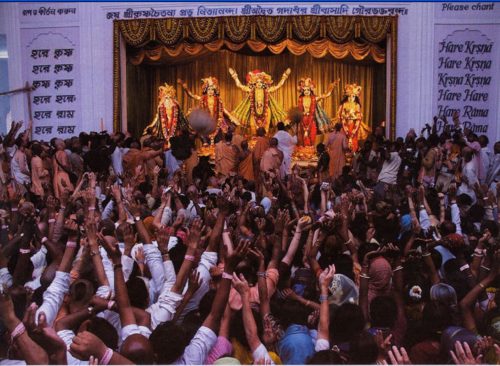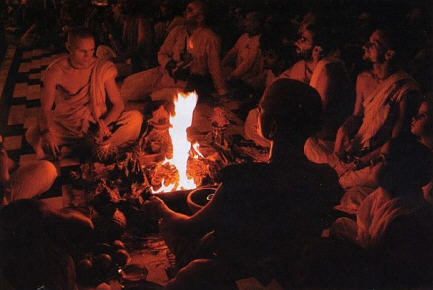Vedic rites and mantras mark the appearance of Sri Panca-tattva in their deity forms.
As the festivities and formalities unfolded in the temple, thousands were drawn into the whirl of color and sound emanating from the main altar as Sri Panca-tattva were unveiled for the first time. Amongst the activities, one stood out in its beauty and intensity: the yajna, or fire sacrifice, being carried out center-stage. Huge flames licked the forty-foot-high ceiling, urged on by great wooden spoonfuls of ghee (clarified butter) and accompanied by a chorus of strong voices chanting Vedic mantras and prayers. This is tattva homa, one of the six rites of the deity installation process a magical, spiritual, esoteric journey for the senses, mind, and spirit.
The Vedic scriptures teach that the Lord's name, form, qualities, and pastimes are identical to Him. Thus the deity, as the Lord's form, and the Lord Himself are identical. Then why the need for an installation? Essentially, the installation process formalizes the Lord's manifestation. It is a conscious acknowledgment, a contract, so to speak, between the devotee and the Lord, whom the devotee requests to be formally present and to reciprocate with a certain standard of worship. Krsna says in the Bhagavad-gita (4.11), ye yatha mam prapadyante: "As all surrender unto Me, I reward them accordingly."
Just as the chanting of the maha-mantra Hare Krsna, Hare Krsna, Krsna Krsna, Hare Hare/ Hare Rama, Hare Rama, Rama Rama, Hare Hare destroys the false ego and gradually awakens the spiritual identity of the chanter, so the six rites of the installation process symbolize a twofold theme: purifying the material elements the deity was carved from, and "re-creating" the deity from spiritual ingredients. In other words, the theme of the installation is purifying matter and transforming it into spirit. Srila Prabhupada explains this process in his SriIsopanisad ,Mantra-8, commentary:
The Lord's worshipable form (arca-vigraha), which is installed in temples by authorized acaryas who have realized the Lord in terms of Mantra Seven, is nondifferent from the original form of the Lord. The Lord's original form is that of Sri Krsna, and Sri Krsna expands Himself into an unlimited number of forms, such as Baladeva, Rama, Nrsimha, and Varaha. All of these forms are one and the same Personality of Godhead. Similarly, the arca-vigraha worshiped in temples is also an expanded form of the Lord. By worshiping the arca-vigraha, one can at once approach the Lord, who accepts the service of a devotee by His omnipotent energy. The arca-vigraha of the Lord descends at the request of the acaryas, the holy teachers, and works exactly in the original way of the Lord by virtue of the Lord's omnipotence. Foolish people who have no knowledge of SriIsopanisad or any of the other sruti-mantras consider the arca-vigraha, which is worshiped by pure devotees, to be made of material elements. This form may be seen as material by the imperfect eyes of foolish people or kanistha-adhikaris, but such people do not know that the Lord, being omnipotent and omniscient, can transform matter into spirit and spirit into matter, as He desires.
Chanting and Deity Worship
Chanting of the Hare Krsna maha-mantra with a prayer for the Lord to appear in the deity form is the most essential aspect of the deity installation process. Therefore during the installation ceremony at ISKCON's Krsna-Balarama temple in Vrndavana in 1975, Srila Prabhupada told devotees that kirtana is sufficient to install deities. Still, he arranged for local brahmanas to perform the installation yajna so that the residents of Vrndavana would accept that the deities had been "officially" installed.
In former ages, the means of attaining spiritual perfection were complicated and required a high degree of purity of mind and senses that is difficult to attain in Kali-yuga. Those methods included meditation, deity worship, and sacrifice. The Srimad-Bhagavatam (12.3.52) states:
krte yad dhyayato visnum
tretayam yajato makhaih
dvapare paricaryayam
kalau tad dhari-kirtanat
"Whatever result was obtained in Satya-yuga by meditating on Visnu, in Treta-yuga by performing sacrifices, and in Dvapara-yuga by serving the Lord's lotus feet [through deity worship] can be obtained in Kali-yuga simply by chanting the Hare Krsnamaha-mantra."
Then why so much ritual in the installation of Sri Sri Panca-tattva, who appeared to establish the chanting of Hare Krsna as the religion of this age? One could even take the question further and ask, why the need for deity worship in this age? The answer is that while meditation, deity worship, and yajnas are less relevant methods of worshiping the Lord in Kali-yuga, when employed in subordination to the chanting of the holy name they make a powerful impression that purifies the mind and senses. Service to the deity through such rituals provides an opportunity for the aspiring devotee to engage his senses in spiritual activity.
The rituals of the deity installation provide a forum for many devotees to be involved in the installation and have a visual experience of the transformational process. For example, when inviting a friend for dinner, one serves a meal as a medium to enjoy the friend's company. Internally the emphasis is on the relationship; externally the focus is the meal. Similarly, with an installation process, our relationship with the Lord is expressed through specific rituals that involve our senses, thus creating an environment for us to experience the transformation in a tangible way.
Six Installation Rituals
The first of the six installation rituals performed over two days is called sodhita pancagavya snana, a Sanskrit term meaning "purification by bathing with five items from the cow." The five ingredients are milk, yogurt, ghee, cow urine, and cow dung, which are sprinkled over the deities. In Vedic culture, everything about the cow is considered sacred and purifying, so this process purifies the deities of any faults that occurred during the carving. It also indicates that the craftsman's external work on the deities is complete and henceforth the priests are assuming responsibility for the deity service.

The second step is called netra unmilinam, or opening the eyes of the deities. In the Eleventh Chapter of the Bhagavad-gita Arjuna tells Krsna, sasi-surya-netram: "The sun and moon are among Your great, unlimited eyes." In this ritual, honey is poured to "open" the eye that is the moon; ghee is used for the eye that is the sun. Once the eyes are opened, mantras sound while auspicious items are shown to the Lord: gold, silver, copper, stone, rice, ghee, yogurt, the Vedic swastika design, water from the Ganges, earth from a holy place.
In the third part, known as sayanadhivasa, the deities are placed on a bed surrounded by many auspicious items. Rice paddy is placed under the bed, which is decorated with beautiful cloth and owers and surrounded by auspicious water pots. Milksweets are offered to the deities and left by the bed overnight. The deities are invited to rest, and devotees stay up all night singing devotional songs.
The fourth ceremony is known as tattva-samhara-nyasa. In this rite the deities are connected to the fire arena by a rope made of kusha grass. The priest touches different parts of the deities' bodies with a kusha-grass stick while chanting a mantra. Thegopala-mantra is chanted backward to destroy the material elements used to create the deities, and then forward in the normal manner to re-create the deities in their spiritual form.
One of the most popular and visual aspects of the installation procedure is the fifth stage, known as abhiseka, or bathing. Rather than merely using water, the priests use pancamrta, or "five nectars"milk, yogurt, ghee, honey, and sugar water. The deities are also bathed in fruit juice, herbal waters, and flower-infused waters. This ceremony culminates with sahasra-dhara, "a thousand streams," when the priests pour water into a silver pot with one thousand tiny holes. Held over the deity's head, it produces a shower of one thousand streams to rinse away all the liquids used to perform the bathing.
The sixth item of installation is known as prana-pratistha, "establishing the life force." The heart of the deity is touched, and He is offered a formal prayer requesting Him to please be present in His deity form. Those performing the ceremony meditate on the Lord in their heart entering the heart of the deity.
At the conclusion of these six processes, the priests conceal the deities behind a curtain to dress them in opulent silk garments, ornament them with jewelry, and offer them a feast of 108 preparations. When the curtain opens, the deities are revealed once again in all Their glory for the pleasure of the assembled devotees, who perform a huge kirtana.
The Chanters
The ritual aspects of the Panca-tattva installation were performed by the students of the Bhaktivedanta Academy, the seed of a Vedic university being developed in Mayapur.

The procedure was conducted according to the directives of Pratistha Viddhi, a manual produced by the Academy for the performance of deity installations and ceremonies accompanying the opening of temples and homes (vastu puja). This manual is based on research compiled by Srila Bhaktisiddhanta Sarasvati Thakura in note form but never published.
The Academy provides for the study, practice, and dissemination of the teachings of Srimad-Bhagavatam, the standard works of the Gaudiya Vaisnava acaryas, and Vedic philosophy, culture, and science all in the context of Srila Prabhupada's teachings.
The boys who performed the fire sacrifice and chanted the mantras during the installation are enrolled in the Sri Yajna Varaha Vidyaksetra, a school of the Bhaktivedanta Academy that offers primary and secondary brahminical education to students between the ages of five and eighteen. These students learn Sanskrit and English; Vedic astronomy and mathematics; Vedic philosophy; Puranic history, geography, and natural science; and Vedic culture, including music, cooking, Vaisnava etiquette, and the performance of Vaisnava rituals (puja, yajna, samskara, mantra chanting, and so on). The training is designed to enable the students to continue their education in the Academy's central college, the Sri Rupanuga Paramartha Vidyapitha, after graduation. There students learn fourteen books of Vedic knowledge through Srila Prabhupada's desired courses of Bhaktisastri, Bhaktivaibhava, Bhaktivedanta, and Bhaktisarvabhauma. An honors course supplements each Bhakti level, and students may take advanced-degree courses designed and established by Srila Bhaktisiddhanta Sarasvati Thakura. The aim of this training is to equip the students as spiritual leaders and caregivers.
In the northeast corner of the Mayapur Project Master Plan, the Bhaktivedanta Academy campus, where the boys live, is being developed as a traditional Vedic ashram according to principles of Vastu Sastra. In line with Srila Prabhupada's concept of "simple living and high thinking," and to maintain a mode-of-goodness atmosphere, the campus, constructed using traditional local methods, is situated in a garden setting with swimming ponds and recreational fields. The kitchen, residences, and school buildings are constructed with traditional thatched roofs and walls of woven bamboo. A library houses ten thousand books for study and curriculum development.
